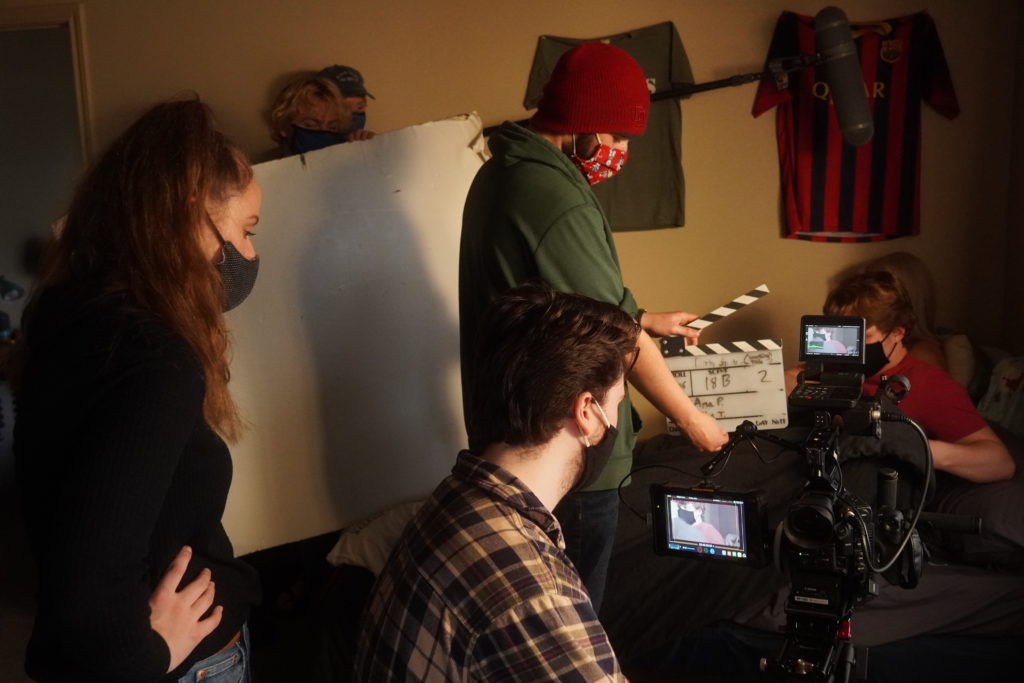
Film students are in the final stages of preparing their senior capstone projects. Billy Palumbo, visiting professor of film, said all of the film shoots have followed COVID-19 safety guidelines to keep the crew and actors safe. He said those guidelines began last summer, and the department closely followed procedures based on existing professional standards.
“We looked at what some of the production companies in other states were doing. We looked at what the Oklahoma office recommended and what the Georgia office was recommending since they were the states that were opening up first,” Palumbo said.
Palumbo said COVID-19 restrictions have not limited the creative vision of any of the filmmakers, but instead inspired them to look at creative ways to solve problems.
“They can think ahead of time at what limitations there will be,” Palumbo said. “One of the students is making a film that takes place partially at a comedy club. At first, we were concerned about the number of extras, but once we looked at the space, we realized it was big enough that people could actually be there safely and spread out.”
Palumbo said the greatest limitation on set is the added time of production due to mitigation standards.
“The students have really been following the rules really well. It takes some getting used to keep people separated a little bit,” Palumbo said. “It can slow things down a little bit, when you have to add breaks to give people time to not be breathing on each other, but I think it’s been pretty smooth so far.”
Ana Pellar, theatre and performance senior with double minors in directing and film, is one of the four seniors directing a capstone. She has just completed her two-weekend shoot, March 6-7 and 13-14, and she is about to transition into the piece’s post-production phase.
“At the beginning of the spring semester we finalize our production, and then each senior has one weekend, or two weekends, based on how long your script is, to shoot your film,” Pellar said.
Pellar said shooting a movie amid COVID-19 rules slows down various aspects of production.
“It is difficult, because generally, the more manpower that you can have on a film set, the more quickly the process of shooting can happen,” Pellar said. “The other thing is, we are wearing masks all the time outside of shooting. So, instead of ‘quiet on set, sound speed, camera, action,’ it’s now, ‘quiet on set, sound speed, masks off, camera, action.”
Pellar said each small rule adds bits of time which need to be accounted for in the planning phase. She said she has also had to be more mindful about the spaces production happens in.
“We traditionally have meals on set. As the director, you are in charge of that for your crew and cast. So, I have to be mindful of the space and locations that I choose and where we can spread out to eat food,” Pellar said.
Pellar said the rest of the semester is spent in post-production, preparing the film for a screening at the end of the year.
“You spend the rest of the semester editing and color-grading and putting together your film,” Pellar. “By the end, we usually have a big screening at the Rodeo Cinema off campus, and you have a sit down with the faculty and School of Visual Arts, and they watch your movie, and you have a discussion with them about everything that happened.”
Pellar said the department is looking at the first week of May for the screening, but the exact date has not been chosen yet. She said she knows the screening will likely be more scaled back than past years, with limited seating, and she is not sure whether there will be any online streams of the event.
Palumbo said students can follow OCU Film on Instagram for more CAPSTONE updates.


Leave a Reply